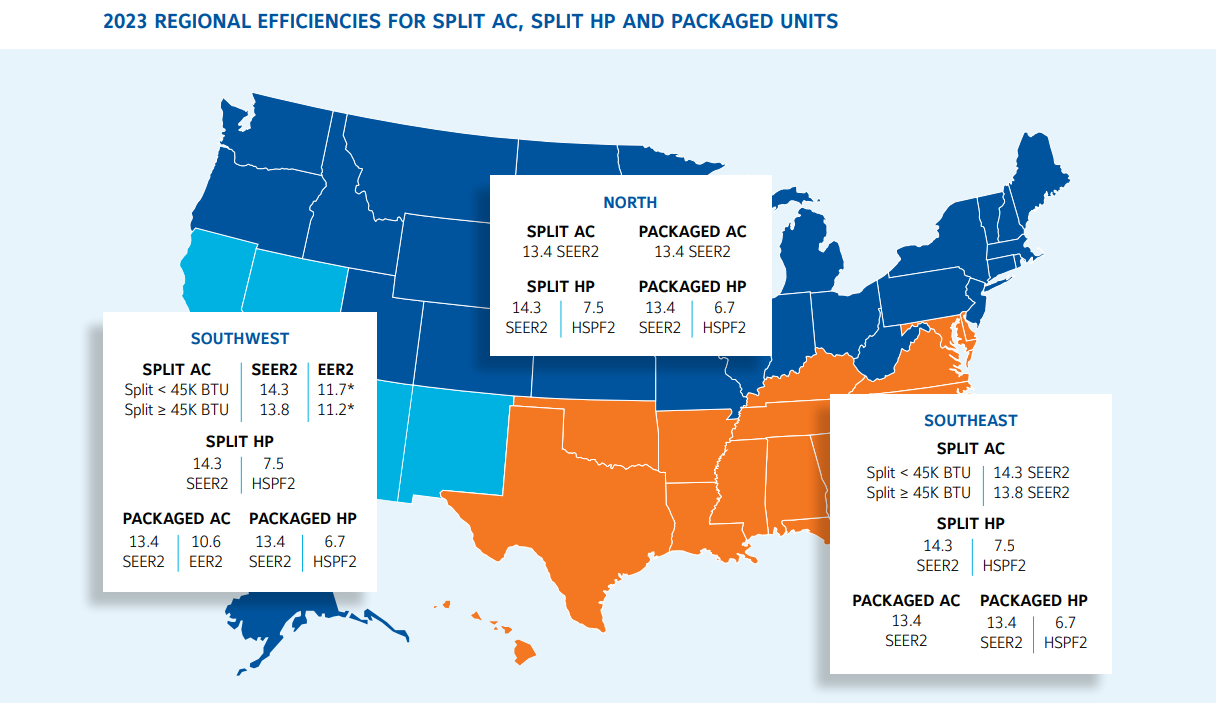DOE STANDARD CHANGES
Find the latest info on state policies and incentives.
ARE YOU FAMILIAR WITH THE DOE CHANGES THAT ARE NOW HERE?
Let us help you stay on top of the changes to better serve your customers and protect your business.
WHAT DO THESE NEW REQUIREMENTS MEAN FOR YOU?
The Department of Energy’s increased efficiency standards take effect on Jan. 1, 2023, replacing the industry measures and regional compliance standards HVAC contractors have referenced for years. Seasonal energy efficiency ratio (SEER), energy efficiency ratio (EER) and heating seasonal performance factor (HSPF) ratings are changing to EER2, SEER2 and HSPF2 ratings.
Key takeaways for installing residential HVAC equipment include:
>Minimum efficiency standards affect air conditioner condensing units (AC), heat pumps (HP)* and single-packaged units (SPP).
>Compliance guidelines are regionally determined and based on manufacture and install dates.
>Installing improper equipment risks steep financial penalties.
RESIDENTIAL CHANGES

Efficiency standards for single split central air conditioners are still divided into three regions: North, South, and Southwest, with higher SEER2 required for the Southern regions (the same as it is today). The new SEER2 minimum will be 13.4 in the North [equivalent to 14 SEER] and 14.3 [15 SEER] in the Southern regions. The new efficiency metrics will be reflected on the updated FTC energy guide labels.
Another difference is that each of the three regions will have different date-of-installation and date-of-manufacture requirements based on product type.
>In the North region, HVAC contractors can continue to sell through and install all equipment built prior to 2023; however, equipment manufactured after Jan. 1, 2023, must meet Appendix M1 testing requirements.
>In the South region, HVAC contractors cannot sell through or install straight AC split-system equipment that doesn’t meet Appendix M1 testing requirements as of Jan. 1, 2023. All other equipment built prior to 2023 can be sold through, but equipment manufactured after Jan 1, 2023, must meet Appendix M1 testing requirements.
>In the Southwest region, HVAC contractors cannot sell through or install straight AC split and packaged systems or packaged G/E equipment that doesn’t meet Appendix M1 testing requirements as of Jan. 1, 2023. All other equipment manufactured prior to 2023 can be sold through based on date of manufacture; however, newly manufactured equipment after Jan. 1, 2023, must meet Appendix M1 testing requirements.
LIGHT COMMERCIAL HVAC EQUIPMENT
All 6- to 30-ton commercial equipment also has efficiency increases and new testing requirements in 2023. While integrated energy efficiency ratio (IEER) and coefficient of performance (COP) testing metrics aren’t changing, commercial equipment in this tonnage range will see a national efficiency increase from the 2018 DOE standard, with EER requirements remaining the same.
For 3- to 5-ton single-phase commercial equipment, standards follow the residential guidelines, and compliance in every region is based on date of manufacture.
For commercial packaged and split systems, national requirements for rated capacities are as follows:
≥ 65,000 < 135,000 BTU/HR
G/E: 14.6 IEER
AC: 14.8 IEER
HP: 14.1 IEER and 3.4 COP
≥ 135,000 < 240,000 BTU/HR
G/E: 14.0 IEER
AC: 14.2 IEER
HP: 13.5 IEER and 3.3 COP
≥ 240,000 BTU/HR
G/E: 13.0 IEER
AC: 13.2 IEER
HP: 12.5 IEER and 3.2 COP
*It’s important to note that the DOE considers heat pumps of all types as a national standard and as thus they are not subject to regional efficiency standards with one exception. The exception is for single package heat pumps in the Southwest, which requires units also meet a minimum EER.